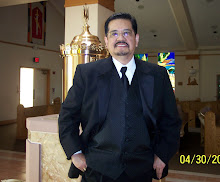Perhaps it is only in the Philippines where a mass at dawn is held for nine days leading to Christmas Day.
It is called "simbang gabi," or "misa de gallo," and commences on the 16th of December and ends on Christmas Eve.
When I was growing up, the misa de gallo in our parish was held at 4 a.m. So my aunt would awaken me and my elder sister Jo and sometimes my kid cousin Ding at 3. But we were always late and had to settle kneeling by the aisle for the duration of the mass that lasted more than one hour.
Oftentimes, I would be seen napping by my aunt.
Those days the December breeze was cooler; killer typhoons and destructive floods were relatively unknown then.
Usually we donned our knit sweaters for the long walk to church.
Since the dawn mass starts on the 16th of December, students who would still attend classes during the day find it difficult to finish the nine day misa de gallo.
When we were kids and studying in a public elementary school, we jockeyed for position at a neighbourhood food stall, "carinderia," for our morning supply of Christmas food like "bibingka," or rice cake, and those violet colored tubular delicacy called "puto bumbong." If we didn't push our light weight around, we'd be late for the 7 a.m. classes.
Aling Agre had the best bibingka and puto bumbong in the Mabini-Castaneda neighbourhood where I grew up.
In Mandaluyong, people filled up the two Christian churches to the brim. The Catholic church, San Felipe Neri started its mass at 5 am, and the Aglipayan Church started an hour earlier.
There was one time when my sister, a cousin and I woke up so early and found the church still closed. We found the Protestant church open and waited there until our church opened up.
The start of misa de gallo also signalled the lighting of the Christmas tree in our household; it was a family tradition that has been continued by my sister Jo. In our own household now, Christmas starts in October with accompanying tree and lights and Nativity Scene or "belen."
Filipinos who are newly migrated to countries such as Canada and the U.S. and other places always find it hard to adjust to the Christmas tradition in these countries. Although Christmas is celebrated lavishly in these parts of the world, the Pinoy still hankers for the Christmas back home.
And this includes the simbang gabi, bibingka and puto bumbong, the "parol" or Christmas lantern, and the "karoling," or neighbourhood kids singing carols from house to house for pennies.
If you're away from home this Christmas and want to feel the Paskong Pinoy, why not try preparing your own puto bumbong. Here's a recipe.
INGREDIENTS FOR PUTO BUMBONG
* 1 cup glutinous rice
* 2 tsp purple food color (ube)
* 2 cups water
* Panutsa (sugar cane sweet) or muscovado (raw brown sugar)
COOKING INSTRUCTIONS
* Soak glutinous rice in water overnight.
* Grind the soaked rice. (see bibingka how)
* Mix food color while the glutinous rice is being ground.
* Wrap the ground glutinous rice on a piece of muslin cloth and place
it in a strainer to drain excess liquid. Another technique in draining
excess liquid is by pressing a heavy object that has been placed over
the muslincloth.
* Once the ground rice has slightly dried, rub it against the screen of a strainer to produce coarse grained rice flour.
* The rice flour for making puto bumbong is now ready to cook. Fill
each bamboo tube (bumbong) with just enough glutinous rice and put them
into the steamer. See to it that the steamer contains boiling water.
* Steam rice flour in the bamboo tubes for 10 minutes.
* Once cooked, shake out the contents of each bamboo tube or remove the
cooked glutinous rice from the bumbong with the help of a knife.
* Spread butter on the puto bumbong and place a small piece of panutsa
(sugar cane sweets) or 1 tbsp. of mascuvado (raw Sugar)
* Add a small amount of grated coconut before serving.
February 9, 2017 – MK 7:24-30
8 years ago









1 comment:
Wow ginutom naman ako. I'm here in Dubai and will miss Paskong Pinoy this year. God bless.
Post a Comment